Reptiles and amphibians: Books about Amphibians
If you want to buy a book, clicking on the book
cover will take you directly to that book on the Amazon.co.uk web site.
See also:
 Cold
water fish for books on ponds for Native European amphibians Cold
water fish for books on ponds for Native European amphibians
 Miscellaneous
general for books on how to make your garden wildlife and pet friendly Miscellaneous
general for books on how to make your garden wildlife and pet friendly
 Books
on lizards Books
on lizards
 Books
on snakes Books
on snakes
 Books
on tortoises, turtles and terrapins Books
on tortoises, turtles and terrapins
 Books on Wildlife-Friendly Gardens Books on Wildlife-Friendly Gardens
 Vet books covering amphibians and reptiles Vet books covering amphibians and reptiles
 News and research on amphibians and reptiles News and research on amphibians and reptiles
 Advice on amphibians Advice on amphibians
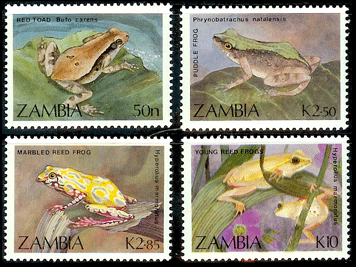
Click
here to see some stamps with reptiles and amphibians on |
 |
|
|
|
|
|
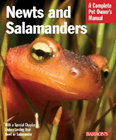
Click on the cover above
to go to this book
at Amazon.co.uk
|

Newts and Salamanders: Complete Pet Owner's Manual
Frank Indiviglio
Barron's Educational Series; 2nd Revised edition (1 April 2010)
ISBN-10: 0764142437
ISBN-13: 978-0764142437
This is probably the best introductory guide to caring for newts and salamanders, amphibians which are sometimes called Caudata. It's a good choice both in terms of how much information it offers, and how easy it is to understand. Frank Indiviglio obviously enjoys writing about Caudata, and knows a lot about the topic. He explains how newts and salamanders live in the wild, which helps in understanding their environment and feeding needs in captivity. There is some information on the needs and characteristics of individual species, which is a useful guide to choosing species, though it's not enough to satisfy a specialist who has decided to focus on a particular species of newt or salamander. The book is well-illustrated, and very good value even if it doesn't tell you everything.
 Top
of page Top
of page
|
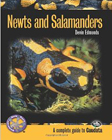
Click on the cover above
to go to this book
at Amazon.co.uk
|

Newts and Salamanders: A Complete Guide to Caudata (Complete Herp Care)
Devin Edmonds
TFH Publications 1st edition (1 Jan 2010)
ISBN-10: 0793828996
ISBN-13: 978-0793828999
Salamanders and newts are fascinating pets, and don't take up much space, but they do need some thought put into creating and maintaining the right environment, as well as providing the right food. This is a useful starter guide to keeping Caudata. Devin Edmonds is a specialist in amphibians, and offers a concise, accessible introduction to newts and salamanders as pets. The book is well-organised, which means that it's easy to find the information you need very quickly. There is some information on individual species, like fire-bellied newts, tiger salamanders, and axolotls, though once you start keeping amphibians, you are likely to want to know more. This book is cheap and cheerful, it won't answer all your questions. It's worth researching newts and salamanders online if you want to know more about Caudata, but this is a handy reference book to have nearby when you are starting out, and the pictures are attractive.
 Top
of page Top
of page
|
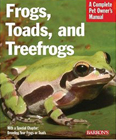
Click on the cover above
to go to this book
at Amazon.co.uk
|

Frogs, Toads and Treefrogs (Pet Owners Manual)
Richard Bartlett and Patricia Bartlett
Barron's Educational Series; 2nd edition (1 Dec 2007)
ISBN-10: 0764136720
ISBN-13: 978-0764136726
The Bartletts have written a very useful introductory guide to toads and frogs, including treefrogs. It is clearly written, and would suit older children who are starting out with frogs and toads. There is information on health issues, as well as housing, feeding and breeding, though the stress is on prevention of health problems rather than treatment. There is some information on individual species, enough for a novice to make an informed choice. The book is well-illustrated, and is quite inexpensive for what it offers. Experienced frog and toad enthusiasts will learn little that they do not already know, but this is about the best starter guide.
 Top
of page Top
of page
|
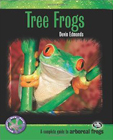
Click on the cover above
to go to this book
at Amazon.co.uk
|

Tree Frogs (Complete Herp Care Series)
Devin Edmonds
TFH Publications (USA) (31 Oct 2007)
ISBN-10: 0793828945
ISBN-13: 978-0793828944
Tree frogs are very popular because they are particularly attractive. They are found in many parts of the world. One of the strengths of this book is its descriptions of the different environments in which treefrogs are found. These descriptions help pet owners to set up the right environment for their treefrogs, feed them the right food, and so keep them healthy. The book is well-illustrated, both with pictures of possible pet environments, and of treefrogs themselves. This is a very useful introductory guide. It is accessible enough for older children. You are likely to need to do more research once you have set up your terrarium, but this book certainly puts you on the right track.
 Top
of page Top
of page
|

Click on the cover above
to go to this book
at Amazon.co.uk
|

Reptiles & Amphibians (Self-Assessment Colour Review)
Fredric L. Frye DVM MSc CBiol FIBiol FRSM, and David L. Williams MA VetMB Cert VOphth MRCVS
Manson Publishing (1 Jan 2005)
ISBN-10: 1874545324
ISBN-13: 978-1874545323
This book is designed for veterinarians and vet students who want to develop their knowledge of reptiles and amphibians. It is an unusual book in that it is both useful for vets, including experienced vets who don't often see herps, and is also accessible enough to be a valuable resource for anyone especially interested in amphibians and reptiles. This includes serious hobbyists who keep herps as pets. The book is also likely to interest anyone studying reptiles and amphibians in the wild, especially those involved in their conservation. Vet books aren't cheap, but there aren't many vets who are specialists in herpetologic medicine, so it pays to develop your own expertise if you have a large collection that you want to keep healthy, or if you have responsibility for wildlife.
 Top
of page Top
of page
|
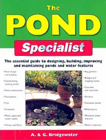
Click on the cover above
to go to this book
at Amazon.co.uk
|

The Pond Specialist: The Essential Guide to Designing, Building, Improving and Maintaining Ponds and Water Features (Specialist Series)
Alan Bridgewater and Gill Bridgewater
New Holland Publishers Ltd (1 Jan 2004)
ISBN-10: 1843303787
ISBN-13: 978-1843303787
The first step to attracting amphibians to your garden is to have the right sort of pond. This book is especially useful for people who want to build and maintain a pond as a haven for native amphibians. The Pond Specialist starts with advice on how to check out your garden to choose the best site. It lists what you are likely to need in terms of materials and tools, and gives advice on electrical wiring, if you plan anything fancy. There is specific advice on wildlife ponds which can offer a haven for amphibians, though this book is just as useful for people wanting to keep fish. The text is easy to follow, and readers are helped by plentiful photos and drawings. The explanations are thorough, there are discussions of advantages and disadvantages of different solutions, and there's lots of specific advice on what to do and what not to do. This book can save you a lot of money if you buy it before embarking on your project, rather than having to rectify expensive mistakes. Other books can tell you more about amphibians and wildlife in general, but this book is especially useful if you want to make a difference by creating a haven for amphibians.
 Top
of page Top
of page
|
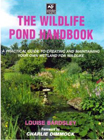
Click on the cover above
to go to this book
at Amazon.co.uk
|

Wildlife Pond Handbook (Wildlife Trusts)
Louise Bardsley New Holland (28 Feb 2008)
ISBN-10: 1845171411
ISBN-13: 978-1845171414
Garden ponds are especially important for the conservation of native amphibians. They help conserve other wildlife, including water insects, birds, and even bats, but arguably, it is amphibians which are most under threat, and which can most benefit from well-constructed and well-maintained ponds. This book offers help on planning, designing, and building ponds designed to attract wildlife. It isn't as thorough on pond construction as the Bridgewaters' The Pond Specialist, but the great strength of the Wildlife Pond Handbook is that the author, Dr Louise Bardsley, is an expert on native amphibians and their conservation needs. She works with English Nature as a Conservation Officer, so can offer invaluable advice on how to create and maintain a sustainable wildlife pond. This involves choosing or encouraging the right inhabitants for your pond, aas well as maintaining it in the different seasons. This is a very useful book, which everyone with a garden pond and an interest in our native wildlife should own.
 Top
of page Top
of page
|

Click on the cover above
to go to this book
at Amazon.co.uk
|

Collins Pocket Guide - Freshwater Life
Malcolm Greenhalgh and Denys Ovenden
Collins; First Edition (5 Mar 2007)
ISBN-10: 0007177771
ISBN-13: 978-0007177776
This is a guide to more than 900 species of freshwater wildlife in the UK and mainland Europe, covering plants, insects, molluscs, and other wildlife, as well as amphibians. It is a useful addition to the library of anyone who is interested in freshwater ecology as a whole, rather than just attracting a few frogs to their pond. The book is very well illustrated, so can help you identify insects which may colonise your pond, enabling you to check whether they can live alongside amphibians or are likely to pose a threat to tadpoles and adults. This is also a useful book to take on holiday anywhere where you are likely to be able to observe freshwater wildlife. The extensive illustrations make the book interesting for younger naturalists who want to know more about what they see in streams and ponds. While this is not the first choice for someone setting up a wildlife pond for amphibians, it will deepen your understanding of native wildlife, and the environment in which amphibians live in the UK.
 Top
of page Top
of page
|

Click on the cover above
to go to this book
at Amazon.co.uk
|

Collins Field Guide - Reptiles and Amphibians of Britain and Europe
Nicholas Arnold and Denys Ovenden Collins; New edition (7 Oct 2002)
ISBN-10: 0002199645
ISBN-13: 978-0002199643
This book is the second edition of a classic, which was already the best guide to European reptiles and amphibians you could find, and which has now been expanded, with more species described, more pictures, and more help with identification. The new edition has been updated in line with the latest research. The distribution maps and illustrations are especially useful. There is also particular help with identifying spawn, and for those who are wary of snakes, there's a guide to the venom characteristics of different species of poisonous snakes. The book is conmprehensive enough for a professional biologist, and accessible enough for amateurs who are just interested in wildlife. A delightful book for nature lovers going on holiday in mainland Europe or the UK, or for anyone who just wants to check out their local herps.
 Top
of page Top
of page
|
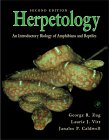
Click on the cover above
to go to this book
at Amazon.co.uk
|

Herpetology: An Introductory Biology of Amphibians and
Reptiles
George Zug, Laurie J. Vitt, Janalee P. Caldwell
Academic Press
ISBN: 012782622X
A little pricey, but you get a lot of book for your money! This is thorough
enough for degree-level students, yet is accessible to the general reader
with an interest in herps. It is the second edition of a well-loved text,
which has been fully revised to bring it up to date and make it easier
to use. Anyone who likes herps will find it fascinating, and it is the
leading work in herpetology for biologists.
 Top
of page Top
of page
|
See also:
 Cold
water fish for books on ponds for Native European amphibians Cold
water fish for books on ponds for Native European amphibians
 Miscellaneous
general for books on how to make your garden wildlife and pet friendly Miscellaneous
general for books on how to make your garden wildlife and pet friendly
 Books
on lizards Books
on lizards
 Books
on snakes Books
on snakes
 Books
on tortoises, turtles and terrapins Books
on tortoises, turtles and terrapins
 Click
here to see some stamps with reptiles and amphibians on Click
here to see some stamps with reptiles and amphibians on
|